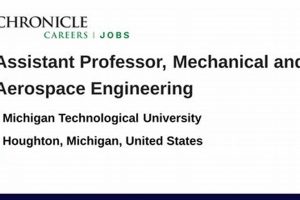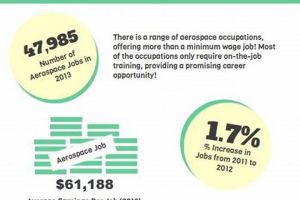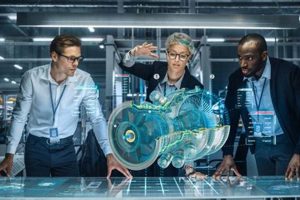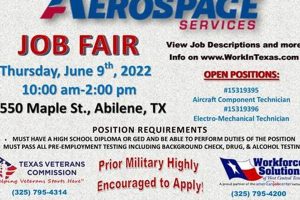The core responsibilities of a professional in this field encompass a broad spectrum of activities related to the design, development, testing, and production of aircraft, spacecraft, and related systems. These tasks require a strong foundation in engineering principles, mathematics, and physics, coupled with the ability to apply this knowledge to real-world challenges. An example of a common task involves developing aerodynamic models to optimize the efficiency and stability of an aircraft wing.
Understanding the specific roles associated with this profession is crucial for effective project management, successful product development, and advancement within the aerospace industry. Detailed knowledge of these activities helps ensure that projects are completed efficiently, safely, and within budget. Historically, a clear definition of these roles has been paramount to the rapid technological advancements observed in both aviation and space exploration.
The following sections will delve into the specific tasks associated with this role, examining the diverse range of responsibilities undertaken by these professionals, including design and analysis, testing and evaluation, and project management.
Essential Guidance for Aerospace Engineering Professionals
The following guidelines aim to provide valuable insights into navigating the complexities of a career focused on the design, development, and testing of aerospace vehicles and related systems. These tips address critical areas to ensure competence and professional growth.
Tip 1: Prioritize Continuous Learning: Given the rapidly evolving nature of aerospace technology, professionals must remain abreast of the latest advancements in materials science, propulsion systems, and avionics. Participation in conferences, workshops, and advanced degree programs is strongly recommended.
Tip 2: Master Simulation Software: Proficiency in industry-standard simulation software, such as MATLAB, ANSYS, and SolidWorks, is paramount. These tools facilitate the modeling and analysis of complex systems, enabling informed design decisions.
Tip 3: Develop Strong Communication Skills: Effective communication is essential for collaboration within multidisciplinary teams. Professionals must be able to clearly articulate technical concepts to both technical and non-technical audiences.
Tip 4: Understand Regulatory Requirements: Familiarity with relevant regulatory standards, such as those established by the FAA and NASA, is critical for ensuring the safety and compliance of aerospace systems.
Tip 5: Emphasize System-Level Thinking: A comprehensive understanding of how individual components interact within a larger system is crucial. This holistic perspective enables the identification and resolution of potential integration issues.
Tip 6: Cultivate Project Management Skills: The ability to effectively manage projects, including scheduling, budgeting, and risk assessment, is vital for delivering successful outcomes.
These guidelines underscore the importance of continuous professional development, technical competence, and effective communication within the aerospace engineering field. Adherence to these principles contributes to the successful design, development, and implementation of advanced aerospace technologies.
The subsequent section will conclude this discussion, offering a final overview of the key considerations for those pursuing a career in aerospace engineering.
1. Design Development
Design development constitutes a core element of the multifaceted role fulfilled by professionals in the aerospace engineering sector. It involves the creation and refinement of blueprints, models, and specifications for aircraft, spacecraft, and related components. This phase requires meticulous attention to detail, a thorough understanding of engineering principles, and the application of specialized software tools. The efficacy of this process directly impacts the performance, safety, and cost-effectiveness of the final product.
The connection between design development and the broader scope of aerospace engineering responsibilities is causal and integral. Flaws or inefficiencies introduced during the design phase can propagate throughout the entire production lifecycle, leading to costly rework, performance limitations, or even catastrophic failures. For instance, an inadequate design of a wing structure could result in excessive drag, reduced lift, and compromised stability. Conversely, a well-executed design optimizes performance parameters, extends operational lifespan, and minimizes maintenance requirements. The development of the Boeing 787 Dreamliner, while innovative, faced setbacks due to early design choices regarding battery systems, highlighting the significant implications of design decisions.
Effective design development in aerospace engineering requires a multidisciplinary approach, integrating considerations from aerodynamics, materials science, propulsion systems, and control systems. The iterative nature of the design process demands constant evaluation, testing, and refinement. A critical aspect is adherence to regulatory standards and safety protocols mandated by agencies such as the FAA and NASA. Furthermore, the advent of advanced computational tools and simulation technologies has revolutionized design development, enabling engineers to analyze complex systems with greater precision and efficiency. Understanding the significance of design development is thus crucial for any aspiring or practicing aerospace engineer, as it forms the foundation upon which successful and safe aerospace systems are built.
2. System Analysis
System analysis forms a critical and inseparable element of the multifaceted duties undertaken by aerospace engineers. This domain involves the methodical evaluation of integrated aerospace systems, encompassing aircraft, spacecraft, propulsion mechanisms, and associated control systems. Its significance lies in identifying potential vulnerabilities, optimizing performance parameters, and ensuring adherence to stringent safety regulations. The process entails employing mathematical models, simulation software, and experimental data to assess system behavior under diverse operational conditions. System analysis is intrinsically linked to the overall success and reliability of aerospace projects. For example, the analysis of a satellite’s communication system ensures that data transmission is stable and secure; flaws in this analysis could lead to critical communication failures.
The practical application of system analysis extends across the entire lifecycle of an aerospace system, from initial design to operational deployment. During the design phase, system analysis tools are used to predict system performance and identify potential design flaws before physical prototypes are constructed. Throughout the testing phase, system analysis facilitates the interpretation of experimental data and the validation of design assumptions. In operational deployment, system analysis supports anomaly detection, fault diagnosis, and predictive maintenance. As an example, stress analysis of an aircraft wing utilizes finite element methods to reveal vulnerabilities under extreme conditions, thereby guiding design modifications to ensure structural integrity. Furthermore, advanced trajectory analysis is essential to mission planning, allowing precise calculation of spaceflight trajectories to achieve optimal fuel consumption and mission success.
In summary, system analysis is not merely a component but rather a foundational pillar of aerospace engineering practices. It provides engineers with the necessary tools and insights to design, test, and operate complex aerospace systems safely and effectively. Mastering system analysis techniques is crucial for any aerospace professional aiming to contribute meaningfully to this technologically demanding field. Challenges remain in the analysis of increasingly complex and autonomous systems, necessitating ongoing research and the development of advanced analytical methodologies. A robust understanding of system analysis is central to safeguarding the integrity and enhancing the performance of next-generation aerospace technologies.
3. Testing Protocols
Testing protocols represent a fundamental element within the scope of aerospace engineering activities. These protocols ensure that aircraft, spacecraft, and related systems meet stringent performance, safety, and reliability standards. The execution and interpretation of these tests form a significant portion of the responsibilities entrusted to aerospace engineers.
- Structural Integrity Testing
This facet involves subjecting aerospace components to extreme loads and environmental conditions to verify their structural integrity. Examples include static load testing of wing structures and thermal cycling of spacecraft components. Aerospace engineers analyze the resulting data to identify potential failure points and validate design assumptions.
- Aerodynamic Performance Testing
This area focuses on evaluating the aerodynamic characteristics of aircraft and spacecraft. Wind tunnel testing, computational fluid dynamics (CFD) simulations, and flight testing are commonly employed. Aerospace engineers use these tests to measure lift, drag, stability, and control characteristics, ensuring optimal performance and maneuverability.
- Propulsion System Testing
This aspect covers the testing of rocket engines, jet engines, and other propulsion systems. Tests include thrust measurement, fuel consumption analysis, and emissions monitoring. Aerospace engineers analyze the data to ensure that propulsion systems meet performance requirements and comply with environmental regulations.
- Avionics System Testing
This area involves evaluating the functionality and reliability of aircraft and spacecraft avionics systems, including navigation systems, communication systems, and flight control systems. Hardware-in-the-loop (HIL) simulation and flight testing are common methods. Aerospace engineers verify that these systems operate correctly under various conditions and meet safety standards.
These testing protocols are integral to the duties performed by aerospace engineers, ensuring that aerospace systems are safe, reliable, and perform as intended. The data obtained from these tests informs design improvements, validates simulation models, and ultimately contributes to the advancement of aerospace technology.
4. Project Oversight
Project oversight forms an essential dimension of aerospace engineering activities, encompassing the planning, execution, monitoring, and control of aerospace projects. It is integral to ensuring that projects are completed within budget, on schedule, and to the required performance standards. This aspect of the work necessitates a blend of technical expertise, leadership skills, and management acumen.
- Resource Allocation and Budget Management
Aerospace engineers with project oversight responsibilities are tasked with allocating financial and human resources effectively. This involves creating detailed budgets, tracking expenditures, and ensuring that resources are used efficiently. For example, overseeing the development of a new satellite system would necessitate allocating funds for hardware procurement, software development, and personnel costs, with continuous monitoring to avoid budget overruns.
- Schedule Management and Milestone Tracking
Maintaining project timelines and meeting critical milestones are key responsibilities. Aerospace engineers use project management software and methodologies to develop detailed schedules, track progress, and identify potential delays. The development of a new aircraft engine, for instance, involves numerous milestones related to design, testing, and certification, each requiring careful scheduling and monitoring.
- Risk Management and Mitigation
Identifying and mitigating risks is vital for project success. Aerospace engineers conduct risk assessments to identify potential hazards, develop mitigation strategies, and implement contingency plans. The construction of a space launch facility, for example, carries significant risks related to weather, equipment failure, and safety, all of which require proactive management.
- Team Coordination and Communication
Effective coordination among multidisciplinary teams is essential. Aerospace engineers facilitate communication, resolve conflicts, and ensure that team members are working collaboratively toward project goals. The design of a new spacecraft, for instance, requires collaboration among engineers specializing in propulsion, avionics, and structural mechanics, necessitating clear communication channels and coordination mechanisms.
These facets of project oversight highlight its significance in the context of aerospace engineering work. Effective project oversight ensures that complex aerospace projects are managed efficiently, mitigating risks, and delivering results that meet performance and safety requirements. This multifaceted responsibility underscores the need for aerospace engineers to possess not only technical expertise but also strong leadership and management skills.
5. Materials Evaluation
Materials evaluation constitutes a critical function within the broader scope of aerospace engineering responsibilities. The selection and validation of materials for aircraft and spacecraft components directly influence performance, safety, and longevity. Engineers must rigorously assess material properties, including strength, weight, thermal resistance, and corrosion susceptibility, to ensure suitability for specific applications. Failure to adequately evaluate materials can have catastrophic consequences, leading to structural failures or premature component degradation. For example, the choice of an inadequate composite material for an aircraft wing could result in fatigue cracking under normal flight loads, potentially leading to structural collapse. Therefore, materials evaluation forms an indispensable element of risk mitigation in aerospace engineering.
The duties related to materials evaluation encompass a range of techniques, including non-destructive testing (NDT) methods such as ultrasonic inspection, radiographic analysis, and eddy current testing. These techniques allow engineers to identify flaws or defects in materials without compromising their structural integrity. Furthermore, mechanical testing, such as tensile testing, compression testing, and fatigue testing, provides quantitative data on material properties. These data are then compared against established standards and specifications to ensure compliance. For instance, the materials used in the Space Shuttle’s thermal protection system underwent extensive testing to ensure they could withstand the extreme temperatures encountered during re-entry. The results of these tests directly influenced the design and manufacturing processes, highlighting the integral connection between materials evaluation and engineering design decisions.
In conclusion, materials evaluation is not merely a supporting activity but rather a core competency within the aerospace engineering profession. Effective materials evaluation demands a comprehensive understanding of material science principles, testing methodologies, and regulatory requirements. By diligently evaluating materials, aerospace engineers contribute directly to the safety, reliability, and performance of aircraft and spacecraft. Ongoing research and development in advanced materials and testing techniques continue to drive innovation and enhance the capabilities of aerospace systems, underscoring the enduring importance of this essential function.
6. Regulatory Compliance
Regulatory compliance forms an indispensable and pervasive aspect of aerospace engineer job duties. The aerospace industry operates under strict oversight from governmental bodies like the Federal Aviation Administration (FAA) in the United States and the European Aviation Safety Agency (EASA) in Europe. These agencies establish and enforce regulations to ensure the safety, reliability, and environmental compatibility of aircraft and spacecraft. Aerospace engineers are directly responsible for ensuring that their designs, testing procedures, and operational practices adhere to these regulations. Failure to comply can result in significant penalties, including fines, project delays, or even grounding of aircraft, with severe repercussions for safety and the industry’s reputation.
The impact of regulatory compliance is evident throughout the aerospace product lifecycle. During the design phase, engineers must incorporate safety features and design redundancies mandated by regulatory standards. For instance, the design of aircraft wings must meet specific requirements regarding load-bearing capacity and structural integrity, as defined by FAA regulations (e.g., FAR Part 25). During the testing phase, engineers must conduct rigorous tests to demonstrate compliance with performance and safety standards. Engine certification, for example, necessitates extensive testing to verify that emissions levels remain within regulatory limits (e.g., ICAO Annex 16). Furthermore, during operation, engineers must ensure that maintenance procedures adhere to approved manuals and that any modifications or repairs are carried out according to regulatory guidelines. The Boeing 737 MAX crisis serves as a stark reminder of the potential consequences when regulatory compliance is compromised, highlighting the paramount importance of adhering to established safety protocols.
In summary, regulatory compliance is not merely a procedural formality but an intrinsic element of aerospace engineering practice. It necessitates a thorough understanding of relevant regulations, a commitment to safety, and the ability to integrate compliance considerations into every aspect of the work. As the aerospace industry continues to evolve with innovations like unmanned aerial vehicles (UAVs) and commercial spaceflight, the importance of regulatory compliance will only increase, requiring engineers to remain vigilant and adaptable in their approach to ensuring safety and adherence to established standards.
Frequently Asked Questions Regarding Aerospace Engineer Job Duties
The following section addresses common inquiries concerning the multifaceted responsibilities associated with positions in aerospace engineering. The responses aim to provide clear and informative insights into the profession’s key aspects.
Question 1: What are the primary tasks typically assigned to professionals in this field?
Professionals in this field typically engage in the design, development, testing, and maintenance of aircraft, spacecraft, and related systems. This includes tasks ranging from aerodynamic analysis to the creation of propulsion systems and control mechanisms.
Question 2: How significant is the aspect of regulatory compliance in this career?
Regulatory compliance is paramount. Professionals must ensure all designs and systems adhere to stringent safety and environmental standards dictated by agencies such as the FAA and NASA. Failure to comply can lead to severe legal and operational repercussions.
Question 3: What role does materials science play in the activities of an aerospace engineer?
Materials science is integral. Professionals evaluate the properties of various materials to select those best suited for specific applications, considering factors such as strength, weight, and resistance to extreme conditions.
Question 4: How is testing and validation incorporated into the development process?
Testing and validation are essential phases. Prototypes and components undergo rigorous testing to verify performance, identify potential weaknesses, and ensure adherence to design specifications and safety regulations.
Question 5: What skills beyond technical expertise are crucial for success in this field?
While technical expertise is foundational, effective communication, project management, and problem-solving skills are also critical for collaboration, coordinating complex projects, and addressing unforeseen challenges.
Question 6: How do environmental considerations influence the work?
Environmental considerations are increasingly important. Professionals are tasked with designing systems that minimize emissions, reduce noise pollution, and utilize sustainable materials, reflecting a growing emphasis on environmental responsibility.
These inquiries reflect the broad range of responsibilities and considerations that define the occupation. A comprehensive understanding of these elements is crucial for individuals seeking a career in the aerospace sector.
The following section will summarize the key points.
Conclusion
This exploration has illuminated the breadth and depth of the responsibilities borne by aerospace engineers. These encompass a diverse array of activities, from initial design and analysis to rigorous testing, materials evaluation, regulatory compliance, and comprehensive project oversight. A consistent theme is the criticality of ensuring safety, performance, and adherence to stringent industry standards.
The profession demands a high degree of technical competence coupled with strong analytical, problem-solving, and communication skills. As aerospace technology continues to evolve, professionals in this field must embrace continuous learning and adaptation. The ongoing development of innovative technologies and increased emphasis on sustainability will further shape the future landscape, requiring heightened vigilance and a commitment to excellence in all facets of related activities.







